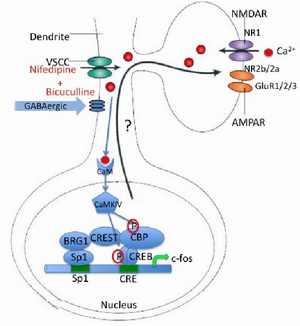One of the most remarkable features of the nervous system is that its structure and function can be modified by sensory input, the research interest of our laboratory is to address mechanisms underlying this process from molecular level. It is now well established that neuronal activity plays a critical role in controlling many aspects of neural development and function, including neuronal viability, migration, morphogenesis, and plasticity (reviewed in Katz and Shatz, 1996). The effects of activity in the nervous system are primarily mediated by calcium signaling. Calcium influx leads to post-translational modification of synaptic proteins as well as induction of new gene expression. The lasting effects of neuronal activity, such as activity-dependent dendritic growth, long-term plasticity in sensory systems, and memory consolidation, require calcium-dependent transcription (reviewed in Flavell and Greenberg, 2008).

During the last two decades we have learned a great deal about the molecular mechanism by which the CREB-associated complex activates gene expression upon calcium influx through glutamate receptors and voltage sensitive calcium channels, which laid the foundation for our understanding of the molecular basis of cognitive behavior (reviewed in Qiu and Ghosh, 2008). Despite these advances, knowledge of how protein products of CREB-dependent transcription contribute to synaptic functions remains very limited. The question of how calcium-dependent gene expression contributes to neural plasticity and cognition has yet to be answered.
Calcium RESponsive Transactivator (CREST) was recently identified as a transcriptional regulator of calcium dependent gene expression in a Transactivator Trap screen in Dr. Anirvan Ghosh’s lab (Aizawa et al. 2004). During his postdoctoral training, Dr. Qiu identified a CREST-containing transcriptional complex and discovered a novel calcium-dependent regulatory mechanism. Importantly, he found that expression of several glutamate receptor genes is regulated by the CREST complex and calcium signaling, which suggests that CREST may contribute to calcium-dependent neural plasticity and cognitive behavior. In future work, the laboratory is interested in addressing the function of CREST on neural plasticity and cognitive behavior in rodents, using molecular biology, electrophysiology and mouse genetics approaches (Qiu and Ghosh, 2008).
Recent studies suggest that activity-dependent adaptive mechanisms, including gene expression, are also implicated in neurological disorders, such as autism spectrum disorders (Morrow et al. 2008). In previous work, Dr. Qiu discovered that a methyl-DNA binding protein-MeCP2 is regulated by the CREST complex. Mutation of MeCP2 gene causes Rett syndrome, one of the most severe autism spectrum disorders affecting child development (reviewed in Chahrour and Zoghbi, 2007). In future research, the laboratory is interested in studying the relationship between calcium-dependent gene expression and neuropathology of autism spectrum disorders. We believe that these studies will greatly improve our knowledge of the molecular basis of cognitive and social behavior, as well as contribute to possible therapeutic treatments for autism spectrum disorders.
Reference:
Aizawa, H., Hu, S. C., Bobb, K., Balakrishnan, K., Ince, G., Gurevich, I., Cowan, M., and Ghosh, A. (2004). Dendrite development regulated by CREST, a calcium-regulated transcriptional activator. Science 303, 197-202.
Chahrour, M., Zoghbi, H.Y., (2007). The story of Rett syndrome: from clinic to neurobiology. Neuron 56, 422-437.
Flavell, S. W., and Greenberg, M. E. (2008). Signaling mechanisms linking neuronal activity to gene expression and plasticity of the nervous system. Annu Rev Neurosci 31, 563-590.
Katz, L.C. and Shatz, C. J.(1996). Synaptic activity and the construction of cortical circuits. Science 274, 1133-1138.
Morrow, E. M., Yoo, S. Y., Flavell, S. W., Kim, T. K., Lin, Y., Hill, R. S., Mukaddes, N. M., Balkhy, S., Gascon, G. et al. (2008). Identifying autism loci and genes by tracing recent shared ancestry. Science 321, 218-223.
Qiu, Z. and Ghosh, A. (2008). A brief history of neuronal gene regulation: regulatory mechanisms and cellular consequences. Neuron 60, 449-455.
Qiu, Z., Ghosh, A. (2008). A Calcium-dependent switch in a CREST-BRG1 complex regulates activity-dependent gene expression. Neuron. 60, 775-787.

Senior Investigator